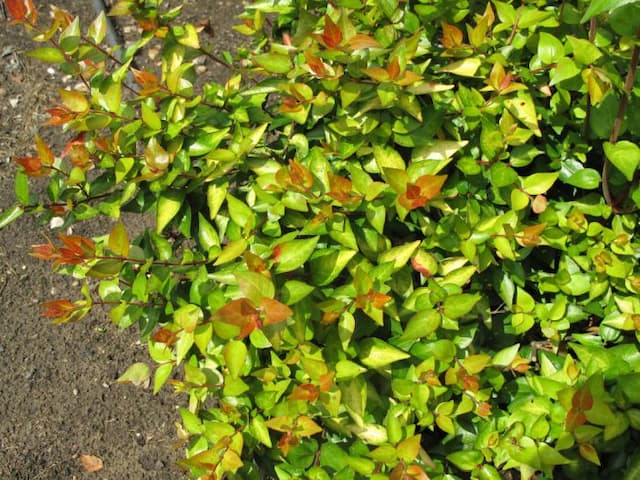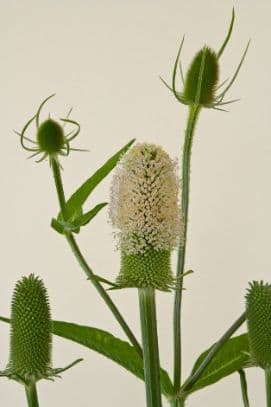Honeysuckle Lonicera 'Spring Purple'

ABOUT
Lonicera 'Spring Purple', often known as the Honeysuckle, is a plant celebrated for its striking features. It typically boasts a lush, intertwined growth habit, creating a dense and vibrant mat of branches and leaves. The leaves of the Honeysuckle are oval-shaped with a pointed tip and exhibit a glossy texture, and their color can be described as a deep green with some variegation in certain cultivars. One of the most attractive aspects of this plant is its flowers. The Honeysuckle produces tubular blooms that are a magnet for pollinators such as bees and hummingbirds. These flowers typically have a two-tone appearance, with a deep purple to magenta coloration on the outside and a contrasting yellow or creamy white interior, which add to their visual appeal. These blossoms also emit a sweet and intoxicating scent, especially during the evening, making them a delightful addition to any space that allows for sensory gardening. Beyond its floral display, some varieties of the Honeysuckle may produce small berries. These berries are often a bold red or orange color, providing a visual feast as well as an additional food source for local wildlife, especially birds, following the flowering season. Overall, the Honeysuckle 'Spring Purple' is a versatile ornamental plant that can add both vibrant colors and delightful fragrances to the landscapes or gardens in which they are placed. Their decorative appeal and ability to attract wildlife make them a prized choice for gardeners looking to create a dynamic and lively garden ecosystem.
About this plant
 Names
NamesSynonyms
Spring Purple Honeysuckle, Spring Purple Woodbine
Common names
Lonicera 'Spring Purple'.
 Toxicity
ToxicityTo humans
Lonicera 'Spring Purple', commonly known as honeysuckle, can have varying levels of toxicity depending on the species. Some honeysuckle berries can be toxic if ingested, leading to symptoms such as stomach upset, vomiting, diarrhea, and could potentially lead to more severe symptoms if consumed in large quantities. However, specific toxicity for 'Spring Purple' cultivar is not well-documented, so care should be taken. If any part of the plant is ingested, it is advisable to seek medical attention.
To pets
Honeysuckle, the common name for Lonicera 'Spring Purple', can be toxic to pets if ingested. The berries especially may cause gastrointestinal upset, evidenced by vomiting and diarrhea. In some cases, ingestion of significant amounts could lead to more severe symptoms that require immediate veterinary care. Pet owners should prevent their animals from consuming honeysuckle plants.
 Characteristics
CharacteristicsLife cycle
Perennials
Foliage type
Deciduous
Color of leaves
Green
Flower color
Purple
Height
6-10 feet (1.8-3 meters)
Spread
5-9 feet (1.5-2.7 meters)
Plant type
Shrub
Hardiness zones
5
Native area
China
Benefits
 General Benefits
General Benefits- Aesthetic Appeal: The Lonicera 'Spring Purple', commonly known as Honeysuckle, produces attractive purple flowers that can enhance the beauty of gardens and landscapes.
- Attracts Wildlife: The flowers provide nectar that is enticing to pollinators like bees, butterflies, and hummingbirds, promoting biodiversity.
- Fragrance: Honeysuckle is known for its sweet and pleasant scent, which can create a fragrant environment in any area where it is planted.
- Growth Habit: It can be trained to grow over trellises, fences, and walls, making it ideal for vertical gardening and space management.
- Shade Provider: When grown as a dense vine, Honeysuckle can provide shade and reduce temperatures in its immediate surroundings.
- Privacy Screen: When planted in rows or as a hedge, Honeysuckle can act as a natural privacy barrier.
- Soil Erosion Control: The root system of Honeysuckle can help stabilize soil and prevent erosion.
- Seasonal Interest: Honeysuckle has seasonal flowers and can retain leaves throughout the year in milder climates, providing year-round interest.
- Adaptability: Honeysuckle is adaptable to a variety of soil types and can tolerate different environmental conditions.
- Low Maintenance: Once established, Honeysuckle requires minimal care and is considered low maintenance, making it suitable for busy gardeners.
 Medical Properties
Medical PropertiesThis plant is not used for medical purposes.
 Air-purifying Qualities
Air-purifying QualitiesThis plant is not specifically known for air purifying qualities.
 Other Uses
Other Uses- Floral Arrangements: The honeysuckle can provide a fragrant and colorful addition to indoor floral arrangements.
- Photography: The striking purple color makes Lonicera an excellent subject for garden and botanical photography.
- Crafts: Dried honeysuckle vines can be used in making wreaths, wall hangings, and other craft projects due to their flexibility and strength.
- Privacy Screening: When grown on trellises or fences, honeysuckles can create a natural privacy screen for your outdoor space.
- Education: The plant can be used for teaching botanical concepts such as plant identification and the structure of a flower.
- Culinary Decoration: While not a common practice, the flowers could be used as a delicate, non-toxic garnish for some desserts or dishes.
- Perfumery: The scent of honeysuckle can be captured in homemade perfumes or potpourri.
- Decorative Dye: The flowers of the Lonicera may be used in experiments to create natural dyes for fabrics or paper.
- Wildlife Shelter: Dense honeysuckle bushes provide shelter and nesting opportunities for many species of birds.
- Sound Barrier: When planted in bulk, honeysuckles can help reduce noise pollution by absorbing and deflecting sounds.
Interesting Facts
 Feng Shui
Feng ShuiThe Honeysuckle is not used in Feng Shui practice.
 Zodiac Sign Compitability
Zodiac Sign CompitabilityThe Honeysuckle is not used in astrology practice.
 Plant Symbolism
Plant Symbolism- Love: Lonicera, commonly known as honeysuckle, often represents love and the bonds of affection due to its twining vines that cling closely to its support.
- Happiness: The bright flowers and sweet scent of honeysuckle are thought to evoke feelings of joy and contentment.
- Generosity: With its abundant and prolific blooms, honeysuckle is sometimes associated with the giving nature of generosity.
- Fidelity: Honeysuckle’s enduring nature, with some species' ability to bloom throughout the season, symbolizes loyalty and devotion.
- Protection: It’s long been believed that planting honeysuckle near homes could protect inhabitants from evil and negative energies.
 Water
WaterHoneysuckle 'Spring Purple' should be watered deeply, making sure moisture reaches the roots. It's best to water this plant once a week with about 1-2 gallons of water, though this may vary depending on climate and soil conditions. During the growing season, increase watering frequency to ensure the soil doesn't dry out completely, especially in hot weather. In the dormant season, reduce watering but don't allow the soil to become bone dry. Ensure good drainage as Honeysuckles do not like waterlogged soil.
 Light
LightHoneysuckle 'Spring Purple' thrives best in full to partial sun. It should receive at least 6 hours of direct sunlight a day but can benefit from some afternoon shade in very hot climates. A spot that gets morning sun and afternoon shade would be ideal to protect it from the intense heat of the day.
 Temperature
TemperatureHoneysuckle 'Spring Purple' is hardy and can tolerate a range of temperatures. It can survive minimum temperatures of about -20 degrees Fahrenheit but prefers a warmer range between 60 to 75 degrees Fahrenheit during the growing season. Extreme heat above 90 degrees Fahrenheit might stress the plant, so some shade or protection during the hottest part of the day could be beneficial.
 Pruning
PruningHoneysuckle 'Spring Purple' should be pruned to maintain shape and encourage bushier growth. The best time to prune is in late winter or early spring before new growth starts. Remove any dead or damaged wood, and trim back overgrown branches to promote air circulation. Annual pruning will also rejuvenate the plant by stimulating new growth and more flowers.
 Cleaning
CleaningAs needed
 Soil
SoilHoneysuckle 'Spring Purple' thrives in moist, well-draining soil high in organic matter, with a pH range of 5.5-7.5. A mix containing loam, peat or compost, and perlite or sand will ensure proper drainage and fertility.
 Repotting
RepottingHoneysuckle 'Spring Purple' should be repotted every 2 to 3 years or when it outgrows its container, to refresh the soil and provide room for growth.
 Humidity & Misting
Humidity & MistingHoneysuckle 'Spring Purple' tolerates a range of humidity levels, but average household humidity is usually sufficient.
 Suitable locations
Suitable locationsIndoor
Place in bright, indirect light and ensure good air circulation.
Outdoor
Plant in sun-to-partial shade with shelter from strong winds.
Hardiness zone
4-9 USDA
 Life cycle
Life cycleLonicera 'Spring Purple', commonly known as Purple Honeysuckle, begins its life cycle as a seed, which once germinated, emerges as a seedling with basic leaves. As a young plant, it establishes a root system and grows rapidly, producing vining stems and more complex leaves adapted to its climbing growth habit. Upon reaching maturity, Purple Honeysuckle develops fragrant purple flowers typically in late spring to early summer, which are pollinated by insects, leading to the production of small red or black berries. These berries contain seeds, enabling the next generation of plants to begin after being dispersed by wildlife or other means. In autumn, it may experience leaf drop, especially in colder climates. Seasonal pruning may influence its growth cycle by stimulating new growth and increasing flower production in the subsequent growing season.
 Propogation
PropogationPropogation time
Spring-Early Summer
The Lonicera 'Spring Purple', commonly known as Purple-Flowering Honeysuckle, is typically propagated through semi-hardwood cuttings. This method is most effectively carried out in late summer, once new growth has begun to mature and harden slightly. To propagate, a 4 to 6 inch cutting is taken from a healthy parent plant, with a sharp, clean pruning tool to minimize damage and disease risk. The lower leaves are removed, and the cut end can be dipped in rooting hormone powder to encourage root development. The prepared cutting is then planted in a potting mix, ensuring the node where the leaves were removed is beneath the soil surface. The cutting needs to be kept moderately moist and in a warm environment with indirect light to facilitate rooting, which usually occurs within a few weeks to a couple of months.








